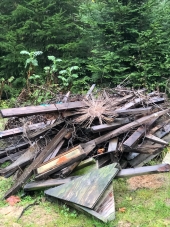I am aware that this topic is quite old, however such is the philosophy of permaculture - older is better... (replacing the latex protection on a fir-toothpick house every 5-10 years is hardly sustainable no?)
In this paper, pay special attention to page 10:
https://www.cedengineering.com/userfiles/Use%20of%20Whole%20Tires%20in%20Earth%20Retaining%20Structures.pdf
This paper is quite obvious, but adds in a polypropylene rope tie, and is a whole mat structure rather than a facia wall:
https://www.cedengineering.com/userfiles/Use%20of%20Whole%20Tires%20in%20Earth%20Retaining%20Structures.pdf
I recently completed construction of a device to cut the sidewall quickly - it consists of a large caster and several roller-blade wheels welded to some scrap steel - this hangs the tire in such a manner that it will spin freely in a relatively controlled rotation. There is then the Harbor Freight 6amp 1/2" drill attached to a hinge assembly via the side handle tapped holes. The drill drives a 12mm (~1/2") steel shaft supported in pillow-block-bearings. On the shaft, I attached a small motorcycle drive sprocket.
The tire is placed on the rack, and the drill is hinged down such that the drive sprocket pinches the tread between it and the large caster. Driving the drill then causes the tire to rotate. There is then a "carpet-knife blade" attached to a hinge, such that it pivots into the sidewall to be cut. It works great, and is my take on some youtube variations of tire-cutters.
I have noticed that the tire becomes a bit more wonky with one side-wall removed however, this is not a problem. The strength of a rammed-earth structure is the inherent compression strength of the fill material - the idea of the tire, or earthbag, or other wire/fabric is to provide confining pressure so as to prevent fracture planes from propagating - this whole philosophy is the concept of Mechanically Stabilized Earth (MSE), the concepts remain the same regardless of the specific mechanical material used. The somewhat wonky tire, when properly compacted, retains its round shape on account of the outward pressure of the fill. The lateral loading is well-handled by wall-system design (geogrid, tire connections, leveling, drainage, etc...) and is not strictly dependent upon the tire remaining whole.
Removing one sidewall to facilitate fill and compaction is quite ideal, and is demonstrated in the above two papers - you CAN use these papers to help convince an engineer if such is required for permitting.
For my own, my system makes use of the cut tire and 20ga chicken wire as a mechanical stabilizer/slope tie-back. I recognize that polypropylene or polyester mesh would be superior to chicken wire as my geogrid reinforcement however, cost is such an issue that it is either the wire, or a lot of prayers :(
With sufficient effort to level and compact the tire, and using the rope-ties outlined in the second paper, in addition to use of the cut sidewalls as further slope-ties and giving the wall a pyramidal-cross-section (bottom course is 4 tires deep, then three, then two, then one... again like the second paper) I see no reason why I should have any trouble.
My fill is decomposed hornblende-gneiss mineral soil (no organics) that holds a dry angle of repose of around 75 degrees - under magnification, it is very coarse/sharp, and when wet then compacted into a test-puc, it makes a very suitable solid mass.
Ultimately, I have no fear that this system (over 9 feet tall, and around 50 feet long) will be able to handle a concrete-truck driving on the area that it makes flat on my 30degree mountain slope.
Actually, using geogrid has a weird effect of becoming stronger under heavy load (crushes fill harder into the grid, making it more resistant to movement)
-----this is why nearly every earth-work in the US Interstate system is MSE.
So, for all that info -
YES, you can most certainly cut the sidewall of the tire for your GH walls, and more than this - YOU SHOULD - it dramatically reduces the time and labor, and there is no appreciable sacrifice in finished wall performance - if it can hold a concrete truck on a mountain, it will laugh at the piddly loading experienced by a GH or earthship.
Have a good day.
(P.S., this post is the result of a few months of research into the OP's question, because I had the same one.)










